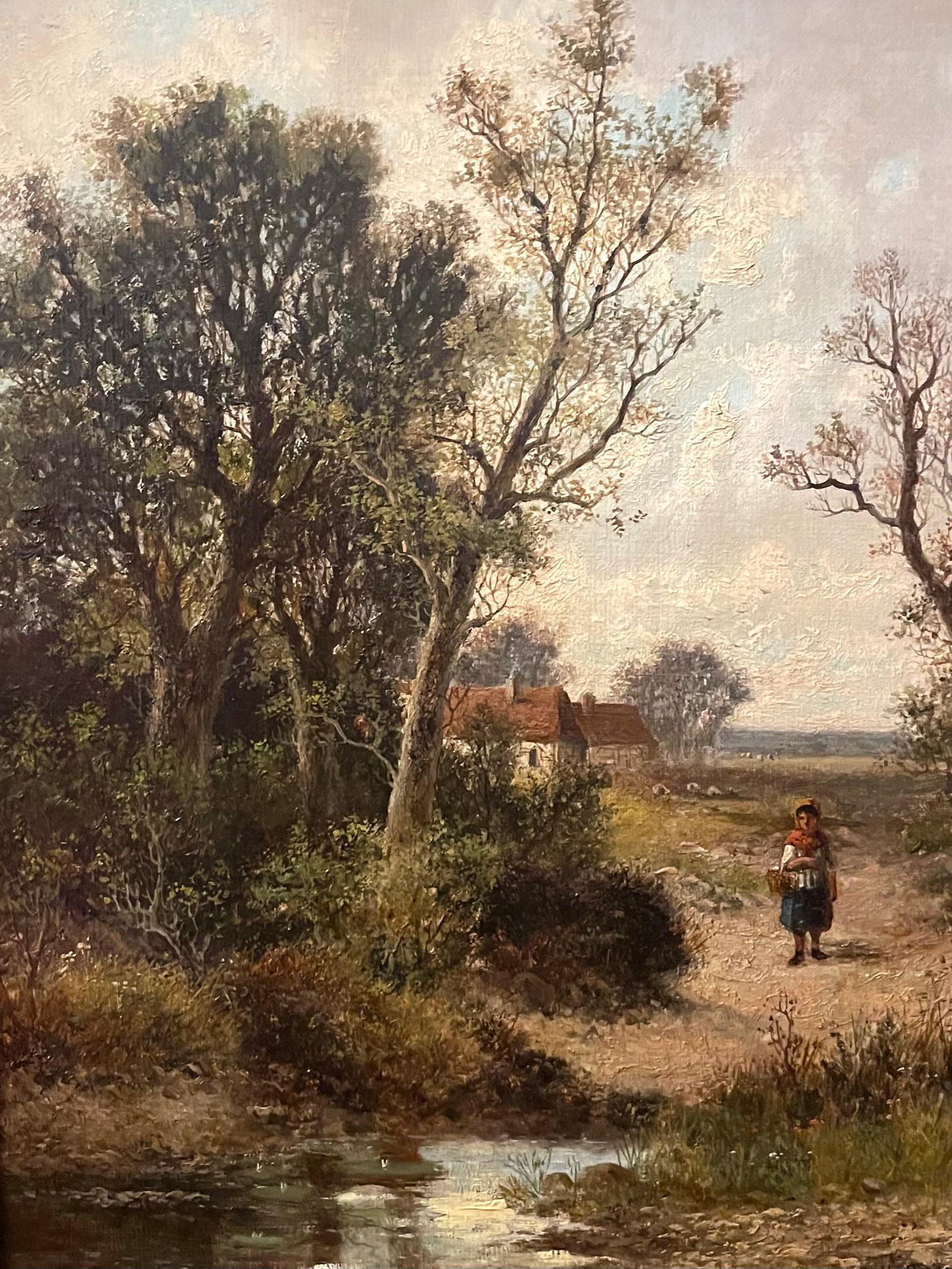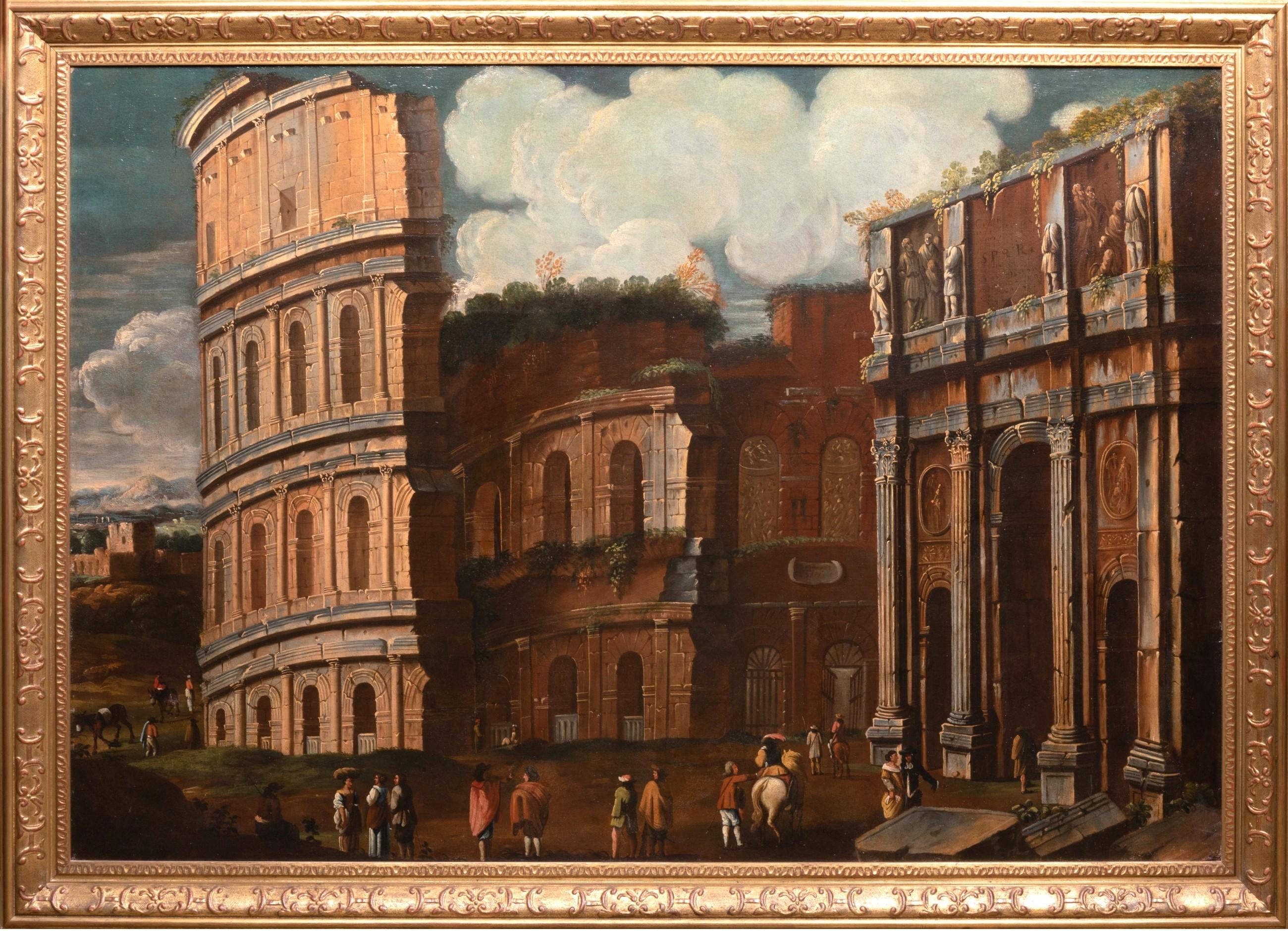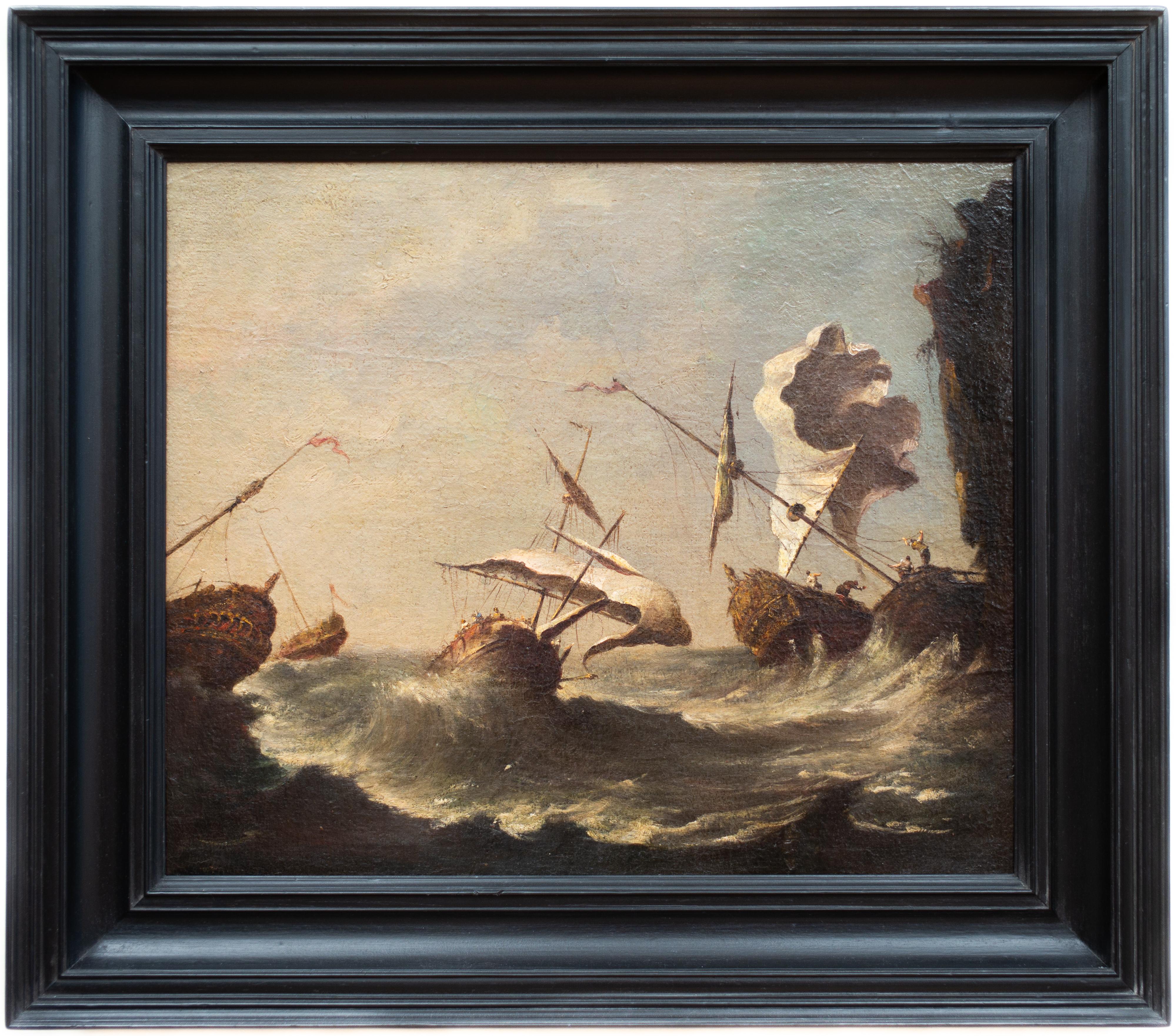Items Similar to Monumental 17th Century Landscape Painting with Figures in an Arcadian setting
Want more images or videos?
Request additional images or videos from the seller
1 of 9
UnknownMonumental 17th Century Landscape Painting with Figures in an Arcadian setting1700s
1700s
About the Item
Enormous 17th Century Italian landscape with figures in Arcadia.
Unframed at present.
Excellent condition.
- Creation Year:1700s
- Dimensions:Height: 47 in (119.38 cm)Width: 67 in (170.18 cm)
- Medium:
- Movement & Style:
- Period:
- Condition:
- Gallery Location:London, GB
- Reference Number:1stDibs: LU67334497731
About the Seller
5.0
Vetted Seller
These experienced sellers undergo a comprehensive evaluation by our team of in-house experts.
Established in 1990
1stDibs seller since 2017
40 sales on 1stDibs
Typical response time: <1 hour
- ShippingRetrieving quote...Ships From: London, United Kingdom
- Return PolicyA return for this item may be initiated within 1 day of delivery.
More From This SellerView All
- Grand 19th Century English Marine Painting in Stunning LightBy John Wilson EwbankLocated in London, GBJohn Wilson Ewbank (1799 - 1847) Shipping in the Harbour, South Shields Oil on canvas 39.5 x 58 inches unframed 47.75 x 66.5 inches framed Provenance: Christie's October 2002; Lot 11. Fine Art Society; Private Collection This marvellous up to scale Ewbank is full of light and warmth and almost certainly his greatest work of the sort rarely - if ever - seen on the market. John W. Ewbank (4 May 1799–28 November 1847), was an English-born landscape and marine painter largely operational from Scotland. The Humber river is a large tidal estuary on the east coast of Northern England. Life Ewbank was born at Darlington on 4 May 1799, the son of Michael Ewbank, an innkeeper. He was adopted as a child by a wealthy uncle who lived at Wycliffe, on the banks of the River Tees, in the North Riding of Yorkshire. Intended for the Roman Catholic priesthood, he was sent to Ushaw College, from which he absconded. In 1813 Ewbank was apprenticed to Thomas Coulson, an ornamental painter in Newcastle. In around 1816 he moved with Coulson to Edinburgh, where he had some lessons with Alexander Nasmyth. He found work both as a painter and a teacher. He was nominated in 1830 one of the foundation members of the Royal Scottish Academy. In 1833 he is listed as living at 7 Union Street on the eastern fringe of the New Town in Edinburgh. Works His sketches from nature were especially admired, and a series of 51 drawings of Edinburgh by him were engraved by W. H. Lizars for James Browne's Picturesque Views of Edinburgh (1825). He also made a reputation with cabinet pictures of banks of rivers, coast scenes, and marine subjects. As an illustrator he illustrated some early editions of Scott's Waverley Novels and one edition of Gilbert White...Category
19th Century Old Masters Figurative Paintings
MaterialsOil
- 18th Century English Oil Landscape Painting: Elegant Figures alongside River WyeBy Attributed to William MarlowLocated in London, GBAttributed to William Marlow (English, 1740-1813) Elegant Figures alongside the River Wye 1790 131 x 152 cm, inc. frame This quiet bucolic scene shows figur...Category
Late 18th Century Old Masters Figurative Paintings
MaterialsCanvas, Oil
- A Beautiful and Large Marine - A Ship in Two Positions Off DoverBy William John HugginsLocated in London, GBWilliam John Huggins (1781-1845) A Ship in Two Positions Off Dover oil on canvas Unsigned 33 x 45 inches, inc. frame William John Huggins, of wh...Category
19th Century Old Masters Figurative Paintings
MaterialsOil
- 18th Century Neoclassical Oil Painting of the Trojan War: Briseis & AchillesBy James ThornhillLocated in London, GBJames Thornhill (1674-1735) Oil on canvas 12 x 14 inches; 16 ½ x 18 ½ in. Inc. frame The subject matter and inclusion of herms on both sides shows the influence of Louis...Category
Early 18th Century Old Masters Figurative Paintings
MaterialsCanvas, Oil
- 17th Century Classical Oil Painting - Diana With Her Attendants in a GrottoBy Abraham van CuylenborchLocated in London, GBAbraham van CUYLENBROCH (1620-1658) Diana With Her Attendants in a Grotto 1651 signed oil on panel 12.2 in x 15.7 inches, inc. frame; 31 x 40 cm Provenance: Sale of Sotheby's Lo...Category
17th Century Old Masters Figurative Paintings
MaterialsOil
- 19th Century French Oil Painting Algeria - Capture of the Smalah of Abd el KaderBy Émile Jean-Horace VernetLocated in London, GBCircle of Emile Jean Horace Vernet (1789-1863) The Capture of the Smalah of Abd el Kader oil on canvas 48 x 55 1/2 in; 121 x 141 cms (including magnificent contemporary carved frame) Provenance Private collection, United States This important and impressive work records the historic skirmish in 1843 between a cavalry unit lead by the duc de Aumale and the Arab chief Abd el Kader during the French military campaign in Algeria. The painting is attributed to Horace Vernet, and relates closely to a major work of the same subject by Vernet now in the Musée de l'Histoire de France in Versailles. The work is a classic example of French Orientalist painting...Category
Mid-19th Century Old Masters Figurative Paintings
MaterialsOil
You May Also Like
- Stag Hunting in the Vicinity of Nuremberg by a German Artist Peter von BemmelLocated in PARIS, FRThis small landscape shows a hunting scene: two riders are chasing a stag with their dogs at the edge of a forest. Signed by Peter von Bemmel, it is typical of the production of this...Category
1720s Old Masters Landscape Paintings
MaterialsCopper
- 17th Century by Simone Cantarini Adoration of The Magi Painting Oil on CanvasLocated in Milano, LombardiaSimone Cantarini (Pesaro 1612 - Verona 1648) Adoration of the Magi Oil on paper applied to canvas, cm. 16,5 x 24 – with frame cm. 22 x 29 Antique sh...Category
Early 17th Century Old Masters Figurative Paintings
MaterialsCanvas, Cotton Canvas, Oil
- Landscape Near Felday, SurreyBy Abraham Hulk the YoungerLocated in Hillsborough, NCDutch/English artist Abraham Hulk the Younger (1851-1922) is most known for landscapes of the British countryside. This work is one of a pair (the second work is also available by s...Category
Late 19th Century Old Masters Landscape Paintings
MaterialsOil, Canvas
- A 17th c. Italian school, Capriccio with the Colosseum, circle of V. CodazziLocated in PARIS, FRA capriccio with the Colosseum in Roma 17th century Italian school Circle of Viviano Codazzi (1604-1670) Oil on canvas Dimensions: h. 35.43 in, w. 51.18 in Modern 17th century style ...Category
17th Century Old Masters Landscape Paintings
MaterialsCanvas, Oil
- A Wooded Landscape With Riders, Attributed to Pieter Gysels, Oil on CopperLocated in Stockholm, SEPieter Gysels, also known as Peeter Gijsels, was a renowned Flemish painter who lived from 1621 to 1690/91. He was known for his landscapes, which often depicted idyllic scenes from nature, and his works are highly sought after by Old Master collectors. We are proud to offer a newly discovered pair of landscapes attributed to him; this one called "A Wooded Landscape With Riders" This stunning painting captures the beauty of a serene summer day in the countryside. In the foreground, we see a couple riding on horsebacks, enjoying the peaceful surroundings. The horses seems to be trotting gently, and the riders are relaxed, taking in the natural splendour around them. In the distance, we see several other figures, perhaps farmers or peasants, doing their daily tasks. We also see a small stream flowing through the landscape, with several small houses. And in the background, we see a beautiful wooded area with tall trees reaching up towards the sky. The attention to detail in this painting is truly remarkable. Gysels use of vibrant colours evoke the warmth and beauty and he skillfully captured the play of light on the landscape, creating a sense of depth and atmosphere. The detailing of the cottages, the colors, the use of big-leafed plants in the foreground, and the figure types are typical of his signature style. "A Wooded Landscape With Riders" is painted on copper, which gives the painting a unique luminosity and depth. The use of copper as a support for paintings was popular in the seventeenth century. We also have one more painting called "Wooded Landscape With an Elegant Company...Category
17th Century Old Masters Figurative Paintings
MaterialsCopper
- Shipping in Stormy Waters, Attributed to Italian Artist Francesco GuardiBy Francesco GuardiLocated in Stockholm, SEThe splendour of the tragic sea Francesco Guardi and maritime painting in Venetian art No Venetian painter was a stranger to the sea. After all, Venice was not only one of the most prominent ports of the Mediterranean, but indeed a city literally submerged in the ocean from time to time. Curiously however, the famous Venetian school of painting showed little interest in maritime motifs, favouring scenes from the iconic architecture of the city rather than seascapes. That is why this painting is a particularly interesting window into not only the painter Francesco Guardi himself – but to the significance of the element of water in art history, in absence as well as in the centre of attention. Whether it be calm, sunny days with stunning views of the palaces alongside the canals of Venice or – more rarely – stormy shipwrecking tragedies at sea, water as a unifying element is integral to the works of painter Francesco Guardi (1712–1793). During his lifetime, Venetian art saw many of its greatest triumphs with names like Tiepolo or Canaletto gaining international recognition and firmly establishing Venice as one of the most vibrant artistic communities of Europe. While the city itself already in the 18th century was something of an early tourist spot where aristocrats and high society visited on their grand tour or travels, the artists too contributed to the fame and their work spread the image of Venice as the city of romance and leisure to an international audience, many of whom could never visit in person. Still today, the iconic image of Venice with its whimsical array of palaces, churches and other historic buildings is much influenced by these artists, many of whom have stood the test of time like very well and remain some of the most beloved in all of art history. It was not primarily subtility, intellectual meanings or moral ideals that the Venetian art tried to capture; instead it was the sheer vibrancy of life and the fast-paced city with crumbling palaces and festive people that made this atmosphere so special. Of course, Venice could count painters in most genres among its residents, from portraiture to religious motifs, history painting and much else. Still, it is the Vedutas and views of the city that seems to have etched itself into our memory more than anything else, not least in the tradition of Canaletto who was perhaps the undisputed master of all Venetian painters. Born into his profession, Francesco lived and breathed painting all his life. His father, the painter Domenico Guardi (1678–1716) died when Francesco was just a small child, yet both he and his brothers Niccolò and Gian Antonio continued in their fathers’ footsteps. The Guardi family belonged to the nobility and originated from the mountainous area of Trentino, not far from the Alps. The brothers worked together on more challenging commissions and supported each other in the manner typical of family workshops or networks of artists. Their sister Maria Cecilia married no other than the artist Giovanni Battista Tiepolo himself, linking the family to the most renowned Venetian name of the time. During almost a decade, Guardi worked in the studio of Michele Giovanni Marieschi, sometimes simply known as Michiel, a painted similar in both style and motif. Canaletto is, however, the artist Guardi is most often compared to since they shared a mutual fascination for depicting the architecture and cityscape of Venice. During the course of his career, Guardi tried his hand in many different genres. He was as swift in painting landscapes, Vedutas of Venice, sacred motifs, interiors and architectural compositions as he was in a number of other motifs. His style is typical of the Venetian school but also distinct and personal once we look a little closer. There is an absolute certainty in the composition, the choice of which sometimes feels like that of a carefully calculated photograph – yet it is also very painterly, in the best sense of the word: fluid, bold, sensitive and full of character. The brushwork is rapid, intense, seemingly careless and extraordinarily minute at the same time; fresh and planned in a very enjoyable mixture. His interiors often capture the breath-taking spacious glamour of the palaces and all their exquisite decor. He usually constructed the motif through remarkably simple, almost spontaneous yet intuitively precise strokes and shapes. The result was a festive, high-spirited atmospheric quality, far away from the sterile and exact likeness that other painters fell victim to when trying to copy Canaletto. The painting here has nothing of the city of Venice in it. On the contrary, we seem to be transported far away into the solitary ocean, with no architecture, nothing to hold on to – only the roaring sea and the dangerous cliffs upon which the ships are just moments away from being crushed upon. It is a maritime composition evoking both Flemish and Italian precursors, in the proud tradition of maritime painting that for centuries formed a crucial part of our visual culture. This genre of painting is today curiously overlooked, compared to how esteemed and meaningful it was when our relationship to the sea was far more natural than it is today. When both people and goods travelled by water, and many nations and cities – Venice among them – depended entirely on sea fare, the existential connection to the ocean was much more natural and integrated into the imagination. The schools and traditions of maritime art are as manifold as there are countries connected to the sea, and all reflect the need to process the dangers and wonders of the ocean. It could symbolize opportunity, the exciting prospects of a new countries and adventures, prospering trade, beautiful scenery as well as war and tragedy, loss of life, danger and doom. To say that water is ambivalent in nature is an understatement, and these many layers were something that artists explored in the most wondrous ways. Perhaps it takes a bit more time for the modern eye to identify the different nuances and qualities of historic maritime paintings, they may on first impression seem hard to differentiate from each other. But when allowing these motifs to unfold and tell stories of the sea in both fiction and reality – or somewhere in between – we are awarded with an understanding of how the oceans truly built our world. In Guardi’s interpretation, we see an almost theatrically arranged shipwrecking scene. No less than five ships are depicted right in the moment of utter disaster. Caught in a violent storm, the waves have driven them to a shore of sharp cliffs and if not swallowed by the waves, crushing against the cliffs seems to be the only outcome. The large wooden ships are impressively decorated with elaborate sculpture, and in fact relics already during Guardi’s lifetime. They are in fact typical of Dutch and Flemish 17th century ships, giving us a clue to where he got the inspiration from. Guardi must have seen examples of Flemish maritime art, that made him curious about these particular motifs. One is reminded of Flemish painters like Willem van de Velde and Ludolf Backhuysen, and this very painting has indeed been mistakenly attributed to Matthieu van Plattenberg...Category
18th Century Old Masters Landscape Paintings
MaterialsCanvas, Oil
Recently Viewed
View AllMore Ways To Browse
Antique Setting
Antique Settings
17th Century Figures
Enormous Landscape
Monumental Old Masters
17th Century Italian Landscape
17th Century Oil Landscape Italian
Monumental Old Masters Oil Paintings
Arcadian Landscape
Arcadia Antique
Arcadian Setting
Vintage Painting Unknown Artist
West Coast Modern
William Holland
L7 Gallery
The Amazon
American Farm Oil Paintings
Antique Painting Uk





